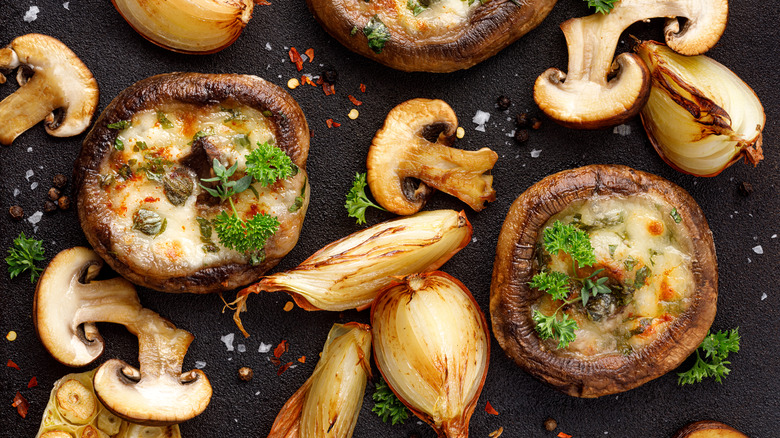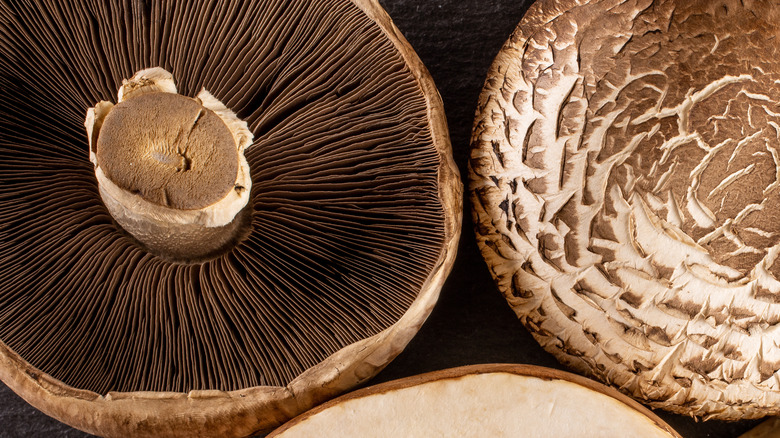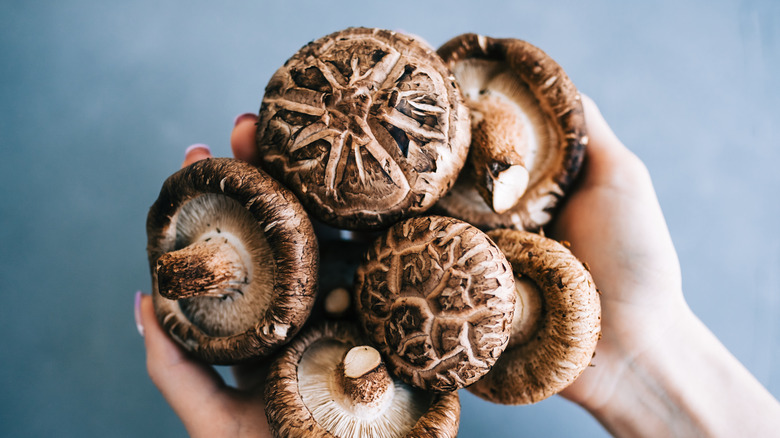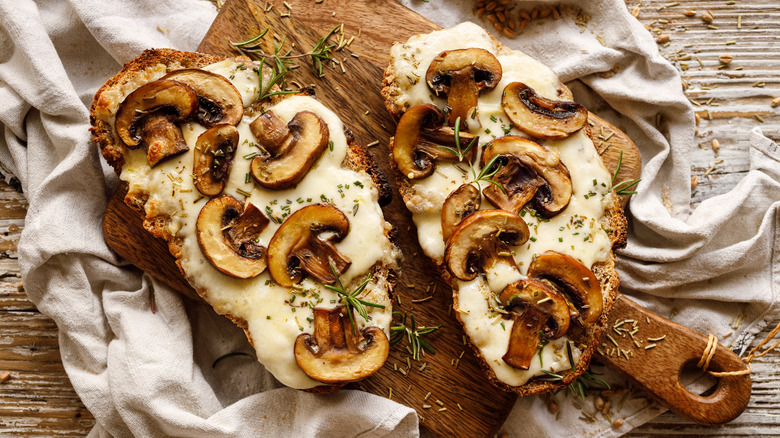Portobello Mushrooms Vs. Shiitake: What's The Difference?
History has shown us that humanity is really good at becoming consumed by interests. We are preoccupied with television shows, fashion trends, musicians, novels, celebrities, and, of course, food. Whether it is the newest health trend, old family recipes, fusion, or something else, many of us partake in the love of food one way or another. We watch things like "The Great British Baking Show," "Iron Chef," and the thousands of foodie videos cluttering TikTok and YouTube.
It's hard not to become preoccupied with something so necessary to life that it is both equally challenging and pleasing. And the further we fall down the rabbit hole, our curiosity about the differences between ingredients mounts. What is the difference between marinara and tomato sauce, Spanish and Italian olive oil, and lamb and mutton? One of the ingredients people have trouble discerning are the different types of mushrooms. And while mushrooms are an extremely diverse and flavorful food group, many do tend to look alike and have a similar earthy taste, but the differences between portobello and shiitake mushrooms are especially tricky to spot if you aren't familiar with the fungi.
What are Portobello mushrooms?
If you see something round and brown smoking on the grill, you might initially think that it's a burger. But in reality, it might actually be a portobello mushroom. The portobello (Agaricus bisporus) is notable for its lovely brown, domed cap which can grow to be as large as six inches in diameter (via Monterey Mushrooms). A Couple Cooks explains that this makes it perfect for the grill. Since it's so big and meaty, the smokiness of the grill lends some natural flavor to these fungi patties. Diffen lists these mushrooms as European and North American in origin. They are most commonly harvested during the chillier months of the year between December and March, though supermarkets will keep them in stock no matter the season (via Rhubarbarians).
Nutritionally, these burger-sized portobellos aren't going to be packed with protein like a beef burger would be. But according to Greatist, they have a good amount of vitamins and minerals as well as antioxidants which are great at limiting the amount of free radicals in the body which can cause all sorts of nasty sounding health conditions.
What are Shiitake mushrooms?
The shiitake mushroom (Lentinus edodes) is widely popular in East Asian cuisine, which makes sense considering it is believed to be native to China (via WebMD). You can find them floating in your miso soup and stir-fried alongside some bok choy. Food & Wine recommends both fresh and dried shiitake mushrooms for any vegetarian dishes that need the addition of an earthy, meaty flavor, much like that of the portobello mushroom. According to MasterClass, shiitake mushrooms can have a huge size range, growing anywhere from 1 to 10 inches! They have a brown, umbrella-like top with a white underbelly and are well-renowned for the rich umami they bring to traditional Asian dishes. Their stalks tend to be a touch woodier than their caps and are often removed and saved for things like soups and stews where they have proper time to soften (via Mushroom Council)
When it comes to the shiitake mushroom's nutritional value, "A Review on General Nutritional Compounds and Pharmacological Properties of the Lentinula edodes Mushroom" sings its praises, claiming that when eaten, this little fungus is beneficial in fighting several bodily disorders and diseases. Not to mention that like the portobello, the shiitake is chocked full of antioxidants.
Can they be swapped?
It feels like that with any new or old recipe, there is always someone who's going to ask, "Can I switch this ingredient out with that?" When it comes down to it, as discussed above, both portobello and shiitake mushrooms have an inherently meaty texture and palate, which means that flavor-wise, these fungi are similar enough that you could switch them out without anyone kicking up too much of a fuss and both make for fantastic meat substitutions in a dish (via Moku Foods).
Something to consider is the size difference. Diffen explains that the portobello is large, whereas the shiitake tends to be medium and sometimes downright small in stature (especially when compared to the portobello). So if you are planning on making stuffed mushrooms or having a lot of mouths to feed, the portobello might be your best call. In addition, the site states that, on average, portobellos are almost 50% cheaper by the pound than shiitake. While it won't make or break your dish to switch these mushrooms out for one another, if you are a stickler for what kind of mushroom you should use for your meals, Eat for Longer suggests using portobello mushrooms for meat substitutes and shiitake mushrooms as flavor enhancers (and not necessarily the star of the dish).



